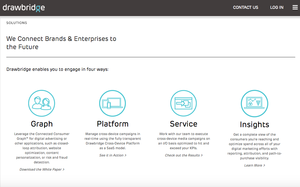Drawbridge Moves To SaaS With Lyft And M&C Saatchi Partnerships
- by Felicia Greiff , April 6, 2016
 Drawbridge is adding to its original ad tech offering: an SaaS model, with Lyft and M&C Saatchi partnerships under its belt
already. Rahul Bafna, VP-product management & partnerships, Drawbridge, said he wouldn't say the company has moved away from its older business,
but that it's expanding with the new business model.
Drawbridge is adding to its original ad tech offering: an SaaS model, with Lyft and M&C Saatchi partnerships under its belt
already. Rahul Bafna, VP-product management & partnerships, Drawbridge, said he wouldn't say the company has moved away from its older business,
but that it's expanding with the new business model. How does he describe Drawbridge? As an "identity company," Bafna said, with one major applications of the company's tech being advertising. (Other applications include content optimization, risk and fraud detection and marketing automation.)
Drawbridge's technology includes its Connected Consumer Graph, which uses an algorithm to connect devices to 1.2 billion consumers. The new model, Bafna said, gives Drawbridge more scale, as well as the ability to work with more customers and different types of customers. After rolling out the model about a year ago, the company is seeing traction with agencies, as well as tech companies that want to monetize proprietary data.
The New Partnerships
Lyft, a rideshare app, is mobile-centric. Its primary goal is getting more people to install the app on their phones and repeatedly
engage with it. Drawbridge began working with Lyft on an insertion-order basis in 2014. Now, Lyft is conducting its programmatic media buying and targeting on Drawbridge's platform SaaS, with functions like setting up campaigns, determining targeting criteria, managing creative assets and getting a better understanding of
ROI.
And for agency client M&C Saatchi Mobile, Bafna said, the big picture is gleaning data from mobile to use on desktop. It's about finding users at lowest prices driving the highest conversion rate.
What's Different
Previously, clients may have come
to Drawbridge with an insertion order and expected the ad opps team to traffic and optimize for them in a very
transactional, not necessarily long-term, arrangement.
"It’s a very heavy-touch, heavy-serviced model," Bafna said. Now, with SaaS, the goal is to get users to use the platform themselves, as with Facebook or Google AdWords, all while offering tools for cross-device delivery and measurement, Bafna added. The benefits include executing a campaign on a single platform, managing the budget at user level, frequency capping at the user level, optimization, targeting, audience profile management, as well as reporting features.
If a user sees an ad on one device and converts on another, those conversions can't be seen when a client uses more than one platform, Bafna said, adding, "I think we’ll start to see more agencies and advertisers move away from two platforms to one platform to manage media spend."
Additionally, Drawbridge doubled its employee count and revenue last year, said Brian Ferrario, VP-marketing, Drawbridge, and the company saw an annualized run rate of $100 million in 2015 Q4.


